新目标九年级英语unit5教学设计方案
- 格式:doc
- 大小:42.50 KB
- 文档页数:6
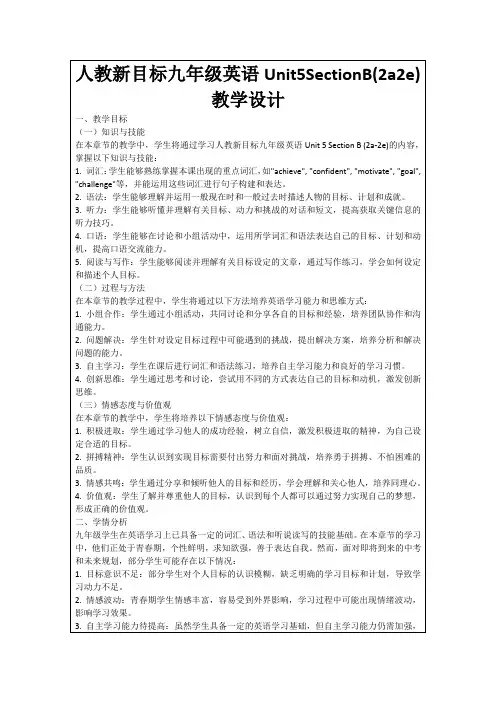
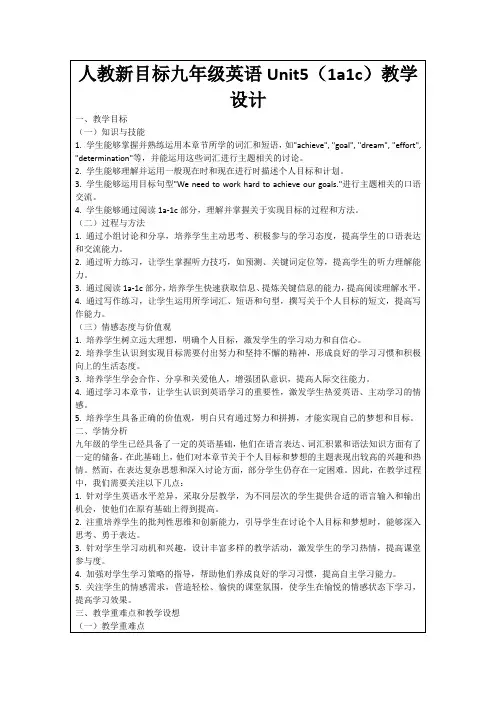
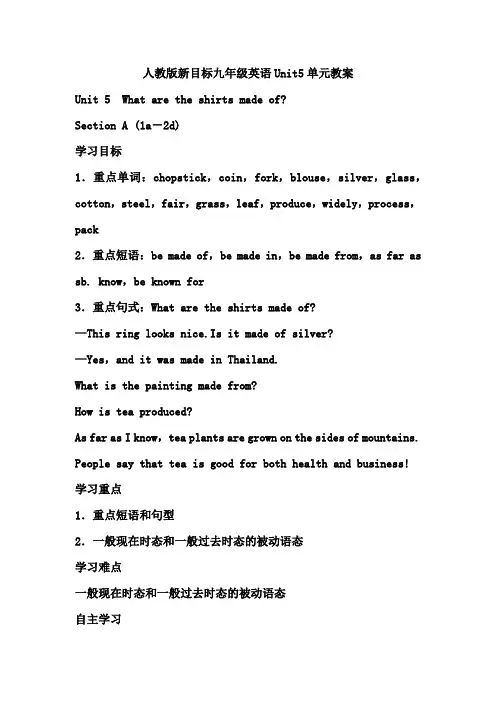
人教版新目标九年级英语Unit5单元教案Unit 5 What are the shirts made of?Section A (1a-2d)学习目标1.重点单词:chopstick,coin,fork,blouse,silver,glass,cotton,steel,fair,grass,leaf,produce,widely,process,pack2.重点短语:be made of,be made in,be made from,as far as sb. know,be known for3.重点句式:What are the shirts made of?—This ring looks nice.Is it made of silver?—Yes,and it was made in Thailand.What is the painting made from?How is tea produced?As far as I know,tea plants are grown on the sides of mountains. People say that tea is good for both health and business! 学习重点1.重点短语和句型2.一般现在时态和一般过去时态的被动语态学习难点一般现在时态和一般过去时态的被动语态自主学习一、预习课本P33-34新单词并背诵,完成下面的汉译英。
1.筷子________ 2.硬币________3.叉子________ 4.衬衫________5.银器________ 6.玻璃________7.棉花________ 8.钢铁________9.展览会________ 10.草地________11.叶子________ 12.生产________13.普遍地________ 14.加工________15.包装________二、认真预习1a-2d找出下列短语和句型。
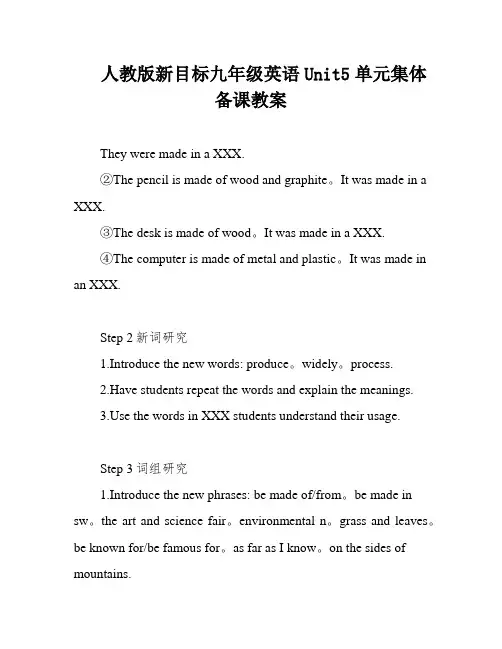
人教版新目标九年级英语Unit5单元集体备课教案They were made in a XXX.②The pencil is made of wood and graphite。
It was made in a XXX.③The desk is made of wood。
It was made in a XXX.④The computer is made of metal and plastic。
It was made in an XXX.Step 2新词研究1.Introduce the new words: produce。
widely。
process.2.Have students repeat the words and explain the meanings.e the words in XXX students understand their usage.Step 3词组研究1.Introduce the new phrases: be made of/from。
be made in sw。
the art and science fair。
environmental n。
grass and leaves。
be known for/be famous for。
as far as I know。
on the sides of mountains.2.Have students repeat the phrases and explain the meanings.e the XXX students understand their usage.Step 4句型研究1.Introduce the sentence patterns: What is the model plane made of。
What is the painting made from。
Is this ring made of silver。
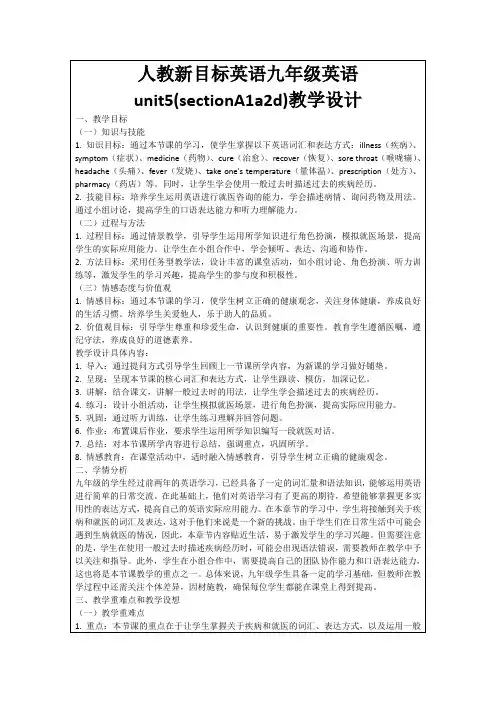
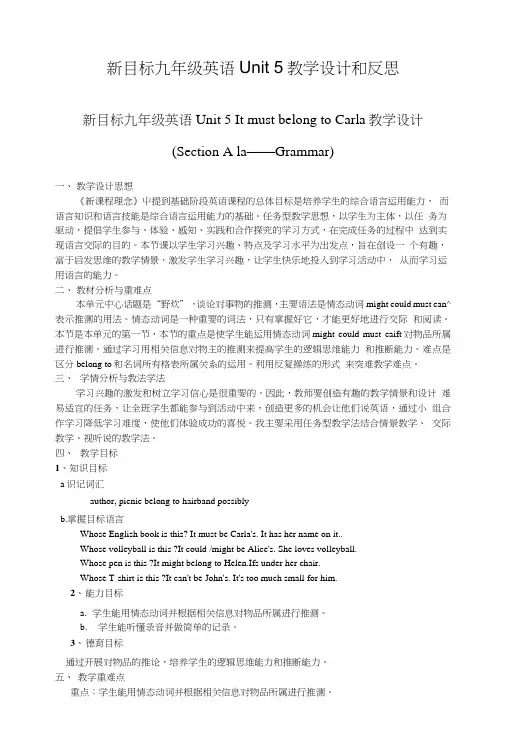
新目标九年级英语Unit 5教学设计和反思新目标九年级英语Unit 5 It must belong to Carla教学设计(Section A la——Grammar)一、教学设计思想《新课程理念》屮提到基础阶段英语课程的总体目标是培养学生的综合语言运用能力,而语言知识和语言技能是综合语言运用能力的基础。
任务型教学思想,以学生为主体,以任务为驱动,提倡学生参与、体验、感知、实践和合作探究的学习方式,在完成任务的过程中达到实现语言交际的目的。
本节课以学生学习兴趣、特点及学习水平为出发点,旨在创设一个有趣,富于启发思维的教学情景,激发学生学习兴趣,让学生快乐地投入到学习活动中,从而学习运用语言的能力。
二、教材分析与重难点本单元中心话题是“野炊”,谈论对事物的推测,主要语法是情态动词might could must can^表示推测的用法。
情态动词是一种重要的词法,只有掌握好它,才能更好地进行交际和阅读。
本节是本单元的第一节,本节的重点是使学生能运用情态动词might could must caift对物品所属进行推测,通过学习用相关信息对物主的推测来提髙学生的逻辑思维能力和推断能力。
难点是区分belong to和名词所有格表所属关系的运用。
利用反复操练的形式来突难教学难点。
三、学情分析与教法学法学习兴趣的激发和树立学习信心是很重要的。
因此,教师要创造有趣的教学情景和设计难易适宜的任务,让全班学生都能参与到活动中来,创造更多的机会让他们说英语,通过小组合作学习降低学习难度,使他们体验成功的喜悦。
我主要采用任务型教学法结合情景教学、交际教学、视听说的教学法。
四、教学目标1、知识目标a识记词汇author, picnic belong to hairband possiblyb.掌握目标语言Whose English book is this? It must be Carla's. It has her name on it..Whose volleyball is this ?It could /might be Alice's. She loves volleyball.Whose pen is this ?It might belong to Helen.Ifs under her chair.Whose T-shirt is this ?It can't be John's. It's too much small for him.2、能力目标a.学生能用情态动词并根据相关信息对物品所属进行推测。
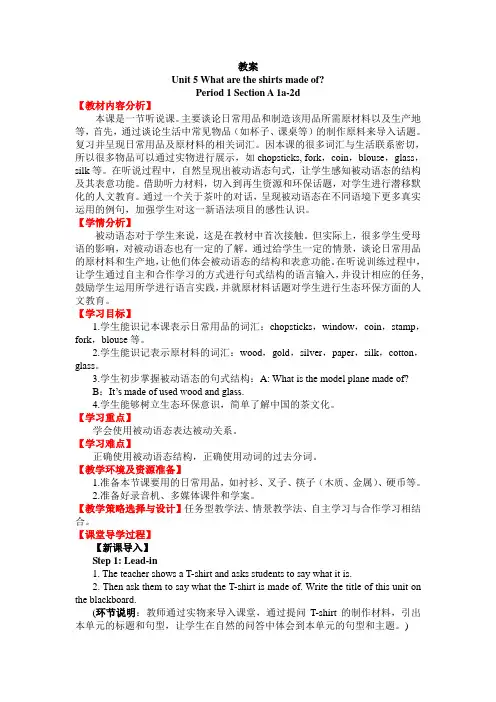
教案Unit 5 What are the shirts made of?Period 1 Section A 1a-2d【教材内容分析】本课是一节听说课。
主要谈论日常用品和制造该用品所需原材料以及生产地等,首先,通过谈论生活中常见物品(如杯子、课桌等)的制作原料来导入话题。
复习并呈现日常用品及原材料的相关词汇。
因本课的很多词汇与生活联系密切,所以很多物品可以通过实物进行展示,如chopsticks, fork,coin,blouse,glass,silk等。
在听说过程中,自然呈现出被动语态句式,让学生感知被动语态的结构及其表意功能。
借助听力材料,切入到再生资源和环保话题,对学生进行潜移默化的人文教育。
通过一个关于茶叶的对话,呈现被动语态在不同语境下更多真实运用的例句,加强学生对这一新语法项目的感性认识。
【学情分析】被动语态对于学生来说,这是在教材中首次接触。
但实际上,很多学生受母语的影响,对被动语态也有一定的了解。
通过给学生一定的情景,谈论日常用品的原材料和生产地,让他们体会被动语态的结构和表意功能。
在听说训练过程中,让学生通过自主和合作学习的方式进行句式结构的语言输入,并设计相应的任务,鼓励学生运用所学进行语言实践,并就原材料话题对学生进行生态环保方面的人文教育。
【学习目标】1.学生能识记本课表示日常用品的词汇:chopsticks,window,coin,stamp,fork,blouse等。
2.学生能识记表示原材料的词汇:wood,gold,silver,paper,silk,cotton,glass。
3.学生初步掌握被动语态的句式结构:A: What is the model plane made of?B:It’s made of used wood and glass.4.学生能够树立生态环保意识,简单了解中国的茶文化。
【学习重点】学会使用被动语态表达被动关系。
【学习难点】正确使用被动语态结构,正确使用动词的过去分词。
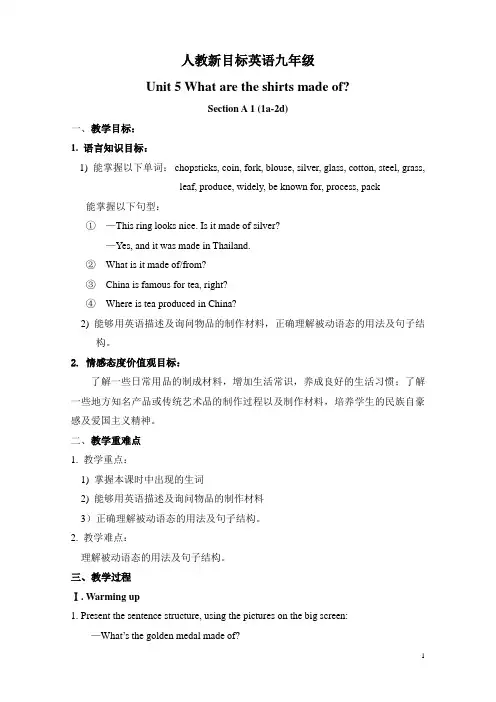
人教新目标英语九年级Unit 5 What are the shirts made of?Section A 1 (1a-2d)一、教学目标:1. 语言知识目标:1) 能掌握以下单词:chopsticks, coin, fork, blouse, silver, glass, cotton, steel, grass,leaf, produce, widely, be known for, process, pack 能掌握以下句型:①—This ring looks nice. Is it made of silver?—Yes, and it was made in Thailand.②What is it made of/from?③China is famous for tea, right?④Where is tea produced in China?2) 能够用英语描述及询问物品的制作材料,正确理解被动语态的用法及句子结构。
2. 情感态度价值观目标:了解一些日常用品的制成材料,增加生活常识,养成良好的生活习惯;了解一些地方知名产品或传统艺术品的制作过程以及制作材料,培养学生的民族自豪感及爱国主义精神。
二、教学重难点1. 教学重点:1) 掌握本课时中出现的生词2) 能够用英语描述及询问物品的制作材料3)正确理解被动语态的用法及句子结构。
2. 教学难点:理解被动语态的用法及句子结构。
三、教学过程Ⅰ. Warming up1. Present the sentence structure, using the pictures on the big screen:—What’s the golden medal made of?—It’s made of gold.—Is this table made of wood?—No, it isn’t. It’s made of glass.—Is Butter made from meat?—No. It’s made from milk.II. Presentation1. Show some pictures on the big screen. Try to learn the new words using “be made of”structure.Learn the new words: chopsticks, coin, fork, blouse, silver, glass, cotton, steel, grass, leaf2. Ss discuss with their partner and try to learn the new words.3. Give Ss five more minutes to remember the new words.4. Work on 1a:Let Ss read the things and materials in 1a. Discuss with their partners and match them with the materials. More than one answer is possible.What are these things usually made of? Match them with the materials. More than one answer is possible.Check the answers with the Ss.III. Listening1.T: Tell Ss they will hear a conversation about some things and material. Listen andmatch the products with what they are made of and where they were made.2. Let one student read the words in the box, Play the recording for the Ss to listen.3. Ss try to listen and match the things with the material and here they were made.4. Play the recording again. Let Ss answer the questions.1) How much did Susan pay for the three shirts?29 dollars.2) What does Anita feel about the three shirts?Cheap.3) What are the shirts made of?Cotton.4) Where were they made?America.5) Where did Susan buy the chopsticks?Korea.6) How does Anita like the chopsticks?Cool.7) What else does Susan show?Ring.8) Where was the ring made?Thailand.9) What will Susan do with the ring?She give it to her friend.IV. Pair work1. Read the conversation in the box in 1c.2. Ss try to made conversations using the information in 1b.e.g. A: Your new shirt looks very nice. Is it made of cotton?B: No, it isn’t. It’s made of silk.3. Let some pairs read out their conversations.V. ListeningPre-listeningfair adj. 公平的; 合理的; 美丽的fair n. an event at which people orbusinesses show and sell productsa book faira trade fairWork on 2a:T: Let’s listen to another conversation between Nick and Marcus.1. What are they talking about? First, let’s look at the pictures and the phrases in 1a.(Let one students read the phrases in 2a.)Listen and check ( √) the main topic of Nick and Marcus’ conversation.____ the science museum____ the art and science fair____ environmental protection____ a model plane____ a beautiful painting____ grass and leaves2. Play the recording for the Ss to listen and check the phrases.3. Play the recording again to check the answers.Work on 2b:1. Let Ss read the sentences below. Explain some main sentences for the Ss. Make sure they know what to do.2. Let Ss read the questions in 2b. Make sure they understand the meaning of each question.Play the recording for the Ss to answer the questions. (If necessary, using the pause button.)1) Where is the art and science fair?_________________________2) Do Nick and Marcus have to pay to go?_________________________3) What is the model plane made of?_________________________4) What is the painting made from?__________________________3. Play the recording again and mark true or false.1) The art and science fair is just inside the science museum.2) The fair is mainly about planes and paintings.3) All the works at the fair were made by university students.4) The model plane is very big.5) The painting is made of wool and grass.6) The students are asked to pay for the art and science fair.7) The students are interested in environmental protection and recycling.VI. Pair work1. Tell Ss to make a conversation using the information in 2a and 2b.e.g.A: What did you see at the art and science fair?B: I saw a model plane.A: What is it made of?B: It’s made of steel, glass, and plastic.2. Let Ss make their own conversations.3. Practice their conversations in pairs.VII. Role-play1. Work on 2dRead the conversation and complete the blanks.1) Chinese _____________ tea both in the past and now.2) _________ I know, tea plants _________ on the sides of mountains.3) When the leaves are ready, they _______ by hand and then _______ for processing.4) The tea ____________ and sent to many different countries and places around China.5) People say that tea ___________ ____ health _____ business!2. Read the conversations and Let Ss read after the teacher.3. Ask Ss to role-play the conversation in groups.VIII. Language points1. What is the model plane made of?What is the painting made from?be made of与be made from 辨析两词组都是“由……制成的”之意。

Unit 5What are the shirts made of?类别课程标准要求掌握的项目话题In this unit, students learn to talk about how we have changed and what we used to be like.重点单词Section A1.chopstick n.筷子2.coin n.硬币3.fork n.餐叉;叉子4.blouse n.(女式)短上衣;衬衫5.silver n.银;银器adj.银色的6.glass n.玻璃7.cotton n.棉;棉花8.steel n.钢;钢铁9.fair n.展览会;交易会10.grass n.草;草地11.leaf n.叶;叶子12.produce v.生产;制造;出产13.widely ad v.广泛地;普遍地14.process v.加工;处理n.过程15.product n.产品;制品16.France 法国17.local adj.当地的;本地的18.avoid v.避免;回避19.handbag n.小手提包20.mobile adj.可移动的;非固定的21.everyday adj.每天的;日常的22.boss n.老板;上司23.Germany 德国24.surface n.表面;表层25.material n.材料;原料26.traffic n.交通;路上行驶的车辆27.postman n.邮递员28.cap n.(尤指有帽舌的)帽子29.glove n.(分手指的)手套Section B30.international adj.国际的31.its adj.它的32.form n.形式;类型33.balloon n.气球34.scissors n.& pl.剪刀35.lively adj.生气勃勃的;(色彩)鲜艳的36.heat n.热;高温v.加热;变热37.complete v.完成重点短语1.be made of/from由……制成2.be made in sp.在某地制造3.the art and science fair艺术与科学展览4.environmental protection环境保护5.be known for/be famous for以……闻名6.as far as I know据我所知7.on the sides of mountains在山边上8.American goods美国商品9.no matter what无论什么10.made in China中国制造11.everyday things日常用品12.high-technology products高科技产品13.fly a kite放风筝14.an international kite festival一个国际风筝节15.objects of beauty美丽的物体16.send out释放17.be covered with被……覆盖18.sky lanterns天灯19.paper cutting剪纸20.a Chinese fairy tale一个中国童话故事21.fire at a very high heat在高温下烧制重点句型1.—What's the model plane made of?这个飞机模型是由什么制成的?—It's made of used wood and glass.它是由废弃的木材和玻璃制成的。
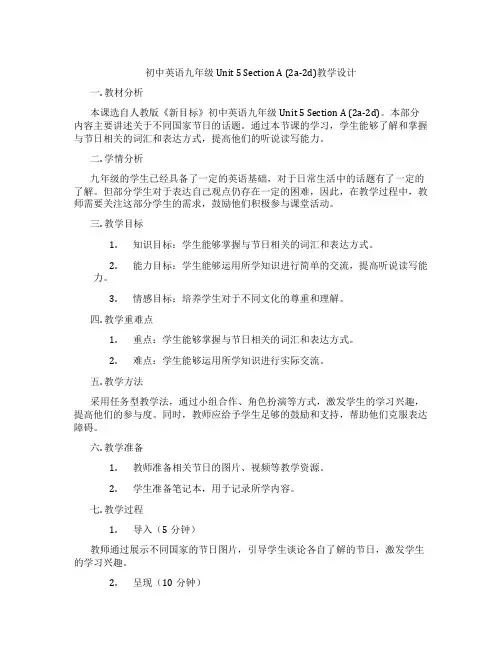
初中英语九年级 Unit 5 Section A (2a-2d)教学设计一. 教材分析本课选自人教版《新目标》初中英语九年级Unit 5 Section A (2a-2d)。
本部分内容主要讲述关于不同国家节日的话题。
通过本节课的学习,学生能够了解和掌握与节日相关的词汇和表达方式,提高他们的听说读写能力。
二. 学情分析九年级的学生已经具备了一定的英语基础,对于日常生活中的话题有了一定的了解。
但部分学生对于表达自己观点仍存在一定的困难,因此,在教学过程中,教师需要关注这部分学生的需求,鼓励他们积极参与课堂活动。
三. 教学目标1.知识目标:学生能够掌握与节日相关的词汇和表达方式。
2.能力目标:学生能够运用所学知识进行简单的交流,提高听说读写能力。
3.情感目标:培养学生对于不同文化的尊重和理解。
四. 教学重难点1.重点:学生能够掌握与节日相关的词汇和表达方式。
2.难点:学生能够运用所学知识进行实际交流。
五. 教学方法采用任务型教学法,通过小组合作、角色扮演等方式,激发学生的学习兴趣,提高他们的参与度。
同时,教师应给予学生足够的鼓励和支持,帮助他们克服表达障碍。
六. 教学准备1.教师准备相关节日的图片、视频等教学资源。
2.学生准备笔记本,用于记录所学内容。
七. 教学过程1.导入(5分钟)教师通过展示不同国家的节日图片,引导学生谈论各自了解的节日,激发学生的学习兴趣。
2.呈现(10分钟)教师呈现2a的内容,让学生听录音并回答问题。
然后,学生两人一组,互相练习2a的对话。
3.操练(10分钟)学生分角色扮演2a的对话,教师巡回指导,纠正发音和表达错误。
4.巩固(10分钟)学生小组合作,根据2a的对话,编写类似的对话,并表演给其他小组观看。
5.拓展(10分钟)教师引导学生讨论不同国家的节日风俗,鼓励学生分享自己的经历。
6.小结(5分钟)教师总结本节课所学内容,强调重点词汇和表达方式。
7.家庭作业(5分钟)学生回家后,用所学知识写一篇关于自己喜欢的节日的短文。
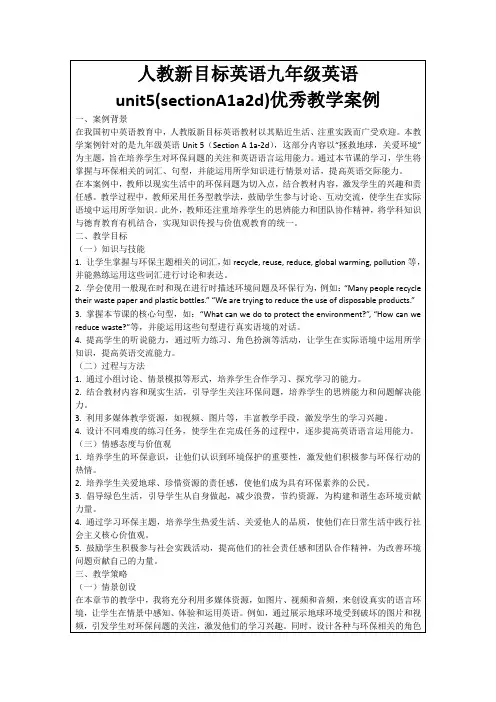
第一课时Sect i on A(1a~2d)1.produce(v.)生产;制造2.wide ly(adv.)广泛地;普遍地3.process(v.)加工;处理8.on the s ides o f mount a ins在山边上.What i s the model p lane made of?这个飞机模型是用什么制成的?2.What i s the pa in t ing made f rom?这幅油画是用什么制成的?3.—Is th i s r ing made of s i lver?这枚戒指是由白银制成的吗?—Yes,and i t was made in Tha i land.是的。
并且它是在泰国制造的。
4.Where i s t ea p roduced in China?在中国,哪些地方产茶?Teacher: P lease t ake out your th ings on your desk.We use them every day,do you rea l ly know them?Ques t ions:教学过程Step 2完成教材1a-1c的任务5.小结训练。
要求学生在规定的时间内完成一个小练习。
并请若干学生给出自己的答案。
有错误的话及时纠正。
(2分钟)用括号内所给动词的正确形式填空。
1)The apples a re sen t(send)to the fac tory f or p rocess ing.2)We are a l l r eady bu t Tom hasn’t packed (pack) h i s c lo thes ye t.3)The windows of the room are c leaned(c lean)every day.4)The bes t co t ton i s p r oduced(p roduce)in Xing J iang in China.5)The song isn’t liked (no t l ike) by mos t o f us.环节说明:通过学习1a,使学生对被动结构有所了解;通过1b,锻炼学生的听力及抓取关键信息的能力;通过1c的训练锻炼学生的口头表达能力,同时巩固对一般现在时被动结构的认识。
人教版新目标九年级英语Unit5单元教案Unit 5 What are the shirts made of?Section A (1a-2d)学习目标1.重点单词:chopstick,coin,fork,blouse,silver,glass,cotton,steel,fair,grass,leaf,produce,widely,process,pack2.重点短语:be made of,be made in,be made from,as far as sb. know,be known for3.重点句式:What are the shirts made of?—This ring looks nice.Is it made of silver?—Yes,and it was made in Thailand.What is the painting made from?How is tea produced?As far as I know,tea plants are grown on the sides of mountains. People say that tea is good for both health and business! 学习重点1.重点短语和句型2.一般现在时态和一般过去时态的被动语态学习难点一般现在时态和一般过去时态的被动语态自主学习一、预习课本P33-34新单词并背诵,完成下面的汉译英。
1.筷子________ 2.硬币________3.叉子________ 4.衬衫________5.银器________ 6.玻璃________7.棉花________ 8.钢铁________9.展览会________ 10.草地________11.叶子________ 12.生产________13.普遍地________ 14.加工________15.包装________二、认真预习1a-2d找出下列短语和句型。
人教版“新目标”英语九年级上册Unit 5 It must belong to Carla第二课时教学设计扶风县南阳初中张红玲一教材简析:本单元围绕情态动词must ,might ,could,can't,进行推理,通过灵活运用这些情态动词培养学生的逻辑判断能力。
本节课在前一节课学习的基础上,让学生进一步明确must ,might ,could,can't在推理时的具体用法。
二教学目标与要求:1,认知目标:词汇:band ,hair band ,句型:Whose notebook is this?It must be Ming`s. It has her name on it.Whose French book is this?It could be Ali's.she studies French.Whose guitar is this?It might belong to Alice. She plays the guitar.Whose T-shirt is this?It can't be Jack's. It's much too small for him.2,能力目标:培养学生的听说读写及推断能力。
3,情感目标:通过推理培养学生的自信心4,教学重难点:运用目标语言及情态动词来进行推理。
5,教学方法:(1)练习法(2)分组讨论法6,教具准备:(1)录音机(2)照片两张(3)一件校服(4)背包(5)发带和手表三教学思路:为了提高课堂教学的有效性,充分调动学生学习的积极性,培养他们自主学习和探究合作的能力。
本节课围绕目标语言,坚持“以生为本”的教学理念,以个别提问,小组合作,课堂检测等形式来展开教学,使学生在深入理解和灵活运用的基础上掌握本节课的知识点。
本节课主要采用“4P”教学模式来进行(受宝鸡市新建路中学赵陶玲老师的“4P”教学模式的启发)分别是(1)Preparation: 我拿了两张自己和儿子以及妹妹的照片,让学生观看并让他们猜照片里的男孩和那个妇女是谁,学生很感兴趣,积极主动的参与到课堂活动中来,在这个基础上我又拿出事先准备好的背包和发带,让他们猜这些物品的主人,在他们猜的过程中,自然而然地进入第二个环节的学习。
人教新目标九年级英语课件 Unit 5 教案Unit 5 Lesson 1: How long have you been collecting shells?教学目标:1. 学习并掌握有关时间段的表达方式,如for+时间段和since+时间点。
2. 学习并掌握现在完成进行时的用法和结构。
3. 能够运用所学知识描述自己和他人的经历和习惯。
教学重点:1. 学习并掌握现在完成进行时的用法和结构。
2. 能够正确使用for+时间段和since+时间点进行时间段的表达。
教学难点:1. 现在完成进行时和现在完成时的区别。
2. 理解并正确使用for+时间段和since+时间点进行时间段的表达。
教学准备:1. 课件:Unit 5 Lesson 1 PPT.2. 教材:人教新目标九年级英语教材第五单元。
教学过程:Step 1: Warm-up (5 minutes)1. Greet the students and ask them about their hobbies.2. Show some pictures of different hobbies on the screen and ask the students if they have ever tried any of them.3. Encourage the students to talk about their hobbies and share interesting stories related to their hobbies.Step 2: Presentation (15 minutes)1. Introduce the new target language: "How long have you been collecting shells?"2. Explain that this question is used to ask about the duration of an action that started in the past and is still happening in the present.3. Present the structure of the present perfect continuous tense: subject + have/has + been + verb-ing.4. Give examples of sentences using the present perfect continuous tense and explain the difference between the present perfect continuous tense and the present perfect tense.5. Introduce the expressions "for" and "since" to indicate the duration of an action.6. Provide examples of sentences using "for" and "since" to express different time periods.Step 3: Practice (20 minutes)1. Divide the class into pairs or small groups.2. Give each group a set of conversation cards with questions related to hobbies and experiences.3. Instruct the students to take turns asking and answering the questions using the present perfect continuous tense and the expressions "for" and "since".4. Monitor the students' conversations and provide assistance as needed.5. After the practice activity, ask some pairs or groups to share their conversations with the class.Step 4: Production (15 minutes)1. Ask the students to think about their own hobbies and experiences.2. Instruct them to write a short paragraph or give a short presentation using the present perfect continuous tense and the expressions "for" and "since".3. Encourage the students to include details about how long they have been doing their hobbies or experiencing certain things.4. Provide feedback and correction on their writing or presentations.Step 5: Review and Summary (5 minutes)1. Review the key points of the lesson, including the use of the present perfect continuous tense and the expressions "for" and "since".2. Summarize the main ideas and encourage the students to ask any remaining questions.Step 6: Homework (2 minutes)1. Assign homework that reinforces the use of the present perfect continuous tense and the expressions "for" and "since".2. Examples of homework assignments could include writing a diary entry using the present perfect continuous tense or creating a dialogue using the target language.教学反思:本节课主要教授了现在完成进行时的用法和结构,以及使用for+时间段和since+时间点进行时间段的表达。